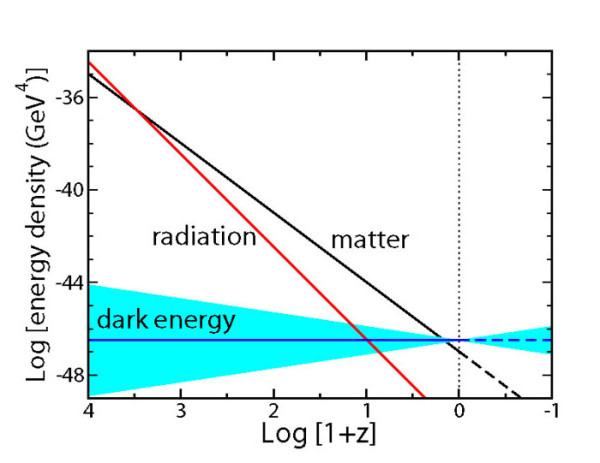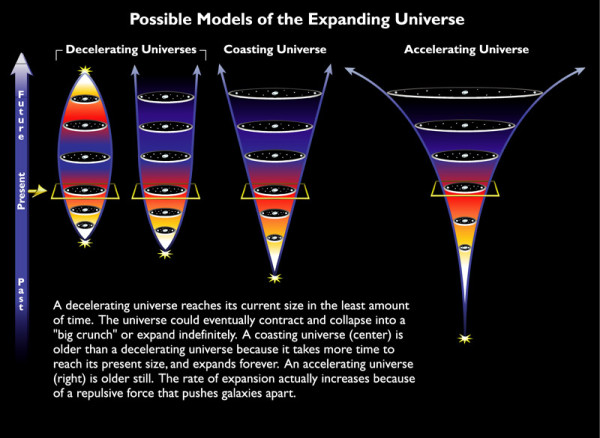“After all the ‘Universe’ is a hypothesis, like the atom, & must be allowed the freedom to have properties & to do things which would be contradictory & impossible for a finite material structure.” -Willem de Sitter
Dark energy was one of the biggest surprises to come along in the past generation, from a scientific standpoint. It's only intuitive to think that the Universe -- with gravity fighting the initial expansion ever since the Big Bang -- and all the galaxies in it would continue to slow down over time. But with a significant positive amount of energy inherent to space itself, that simply isn't the case.
But if we had come along when the Universe was only half its present age, not only would dark energy be virtually undetectable, but the Universe wouldn't have even begun accelerating yet! And furthermore, even the expansion rate today -- a paltry 67 km/s/Mpc -- continues to drop.
 Image credit: Quantum Stories, retrieved via http://cuentos-cuanticos.com/.
Image credit: Quantum Stories, retrieved via http://cuentos-cuanticos.com/.
What do we mean when we say "the Universe is accelerating," and how long has it been doing so? Find out on this week's Ask Ethan!


Let me first thank you about the excellent explanation of the epochs of the universe.
Just when you mentioned that the universe was almost 7.8 billion years old when started accelerating: I think that calculation is based on a '' constant'' cosmological constant ! what if Dark energy was dynamical !? can one expect more than 8 bill years, lets say almost recently !
Thanks again.
Hemza Azri.
Ethan - Here is a physics question for you: In an expanding or contracting universe that is acted on by gravity, I assume that gravitational potential energy is being exchanged for kinetic energy. If so, what is the rule that tells us how that energy exchange is partitioned between accelerating/decelerating objects "through" space, versus "stretching/contracting" the space itself?
(When the exchange goes entirely to stretching the space, can F=ma type mathematics ever be correct?)
Ethan, you almost had it. What if the universe has always been accelerating since the moment of inception? What kind of galactic structures could be build in 211 Gyr? I noticed in one of your blogs that you dismissed a universe without Dark Matter because you couldn't form the current structures in 13.8 Gyr, but what if you had 211 Gyr?
@Donald Airey #3: More time doesn't help. If the Universe has an accelerated expansion, then as you wait longer, the density drops ever faster. With insufficient density, you can't form large local structures.
Michael, Thanks for the response. However, I'm having trouble parsing it. I can choose a constant acceleration for the universe that will leave it with less volume than FLRW after (picking a random point in time, say) 7 Billion years. How are you able to conclude the density is insufficient without knowing what the dynamics of the density are?
@Donald Airey #5: We know the average density of the (observable) Universe today, roughly one atom per cubic meter, and we know the photon/baryon ratio from the CMB, about 10^9.
For the consensus LCDM model and an age of 13.8-ish Gyr, we have simulations which successfully reproduce the currently observed structure starting from the magnitude of density variations expected from observations of the CMB (in particular, the baryon acoustic oscillations).
Those simulations can be (and have been!) varied in order to understand the effect different models, or different parameter values, would have. As an extreme example, if you take away the dark matter, then you discover that as the expansion proceeds, you can't make anything like our observed structures from just baryonic matter.
What I was trying to say above, was that if you have a universe dominated by dark energy, then it expands _faster_ than our actual Universe appears to have done. If you run a simulation with a faster expansion rate, then what happens is that the density drops too fast over time, and there isn't enough stuff in any local region to form the kind of structures we actually observe in our real Universe.
That mismatch, between simulated results vs. observations, rules out the assumptions which went into the simulation.
Michael, this part is very important. You say " if you take away the dark matter, then you discover that as the expansion proceeds, you can’t make anything like our observed structures from just baryonic matter." Do you mean you can't make anything like the universe in just 13.8 billion years, or you can't make the observed universe no matter how long you run the simulation? I've seen multiple sources (including Ethan here) say that you are able to form the filaments and nodes of our universe if you give the simulators hundreds of billions of years to run. Is this true?
@Donald Airey #7: You ask really good questions. In my description, I had included dark energy content, so the expansion rate would not slow down enough to allow long-term structure formation (the mean density would drop faster than gravity could condense out large-scale structure).
You're right that if you build a toy Universe with ordinary matter, and include enough of it that the expansion doesn't accelerate, then given enough time you can probably build something with clumps and filaments roughly similar to what we see.
Of course, that toy model would have lots of other inconsistencies with observational data. The CMB temperature in such an old universe would be much lower than what we observe. I think (but I'm not sure) that clusters would have larger separations, and hence fewer superclusters. With so many more generations of stars, the average metallicity would be extremely high, compared to what we see now (with just three generations).
I think the point Ethan makes in many of his posts is that the evidence for dark matter, and for dark energy, is not just one observation, and not even a few observations. It is a radical concordance of _all_ our data, with many different lines of evidence all leading, independently, to the same conclusion.
Michael, thanks again for the information. It's greatly appreciated.
I've heard this argument before and, frankly, I don't understand it. Concordance is not a proof. Occam's razor isn't a proof either, but in the history of science, Occam's razor has a much better track record as a predictor of a successful theory than concordance. The Ptolemaics had a model that predicted the sunrise, the phase of the moon, the seasons and the retrograde of Mars with great accuracy. Bhor's orbital model also explained several features of the atom, but in the end turned out to be wrong. Newton's theory of gravitation also explained why apples fell from a tree and the moon circled the Earth. So my first question to you is, why do you think concordance is important?
Firstly, I feel secure in saying the Big Bang actually happened. Secondly, it is likely the BB only effected the Milky Way. And thirdly, I feel the expansion of the universe has been infinite. Humans do not comprehend infinity, but I think this is the answer.
Larry, do you understand the difference between opinion and the Scientific Method?
Larry, I can have an opinion that the Earth isn't moving and feel very secure about that opinion. I can also feel very secure in the opinion that I didn't descend from monkeys. Opinions are the worst basis for discovering the true nature of things. That's why we invented the Scientific Method. It was supposed to save us from opinion.
Unfortunately, we find that even today, people have put opinion before the Scientific Method. For example, The Big Bang theory has failed to predict almost anything. It was invented retroactively to explain Hubble expansion. Since then, it has failed every major test of the Scientific Method. When it fails, we go back and patch it up rather than scrapping it and looking for something new.
@Donald Airey #9 et seq. Your last statement (#12) is demonstrably false, and suggests that either you have an agenda which overrides legitimate inquiry, or that you are not familiar with the subject (including many, many of Ethan's posts on the subject). The hot big bang model _predicted_, quite successfully, the abundance of light elements we observe, including the dependence of those light elements on (among other things) the observed density of baryons and the number of light neutrino species. It _predicted_, quite successfully, the cosmic microwave background including its approximate temperature, _before_ the observation of the CMB. Later refinements _predicted_, quite successfully, the large scale structure we observe, with a better fit to that structure using a specific mix of baryonic and dark matter.
Perhaps you would care to enlighten the rest of the physics and astrophysics community about "almost anything" where the big bang model has failed.
The big bang failed to:
(1) Predict a flat universe.
(2) Predict an isotropic universe
(3) Predict a homogeneous universe.
(4) The acceleration of expansion.
(5) The large scale structure of the universe.
The Big Bang did successfully predict the existence of CMB and has done a reasonably good job of Nucleosynthesis, but after missing the first 4, the remaining two are like participation prizes.
The Big Bang failed miserably on the Large Scale Structure of the universe. It wasn't until it was patched up after the fact by Hyperinflation, Dark Matter and Dark Energy that it sort of worked. Hyperinflation, BTW, is the opposite of the Scientific Method. They started with the answer (a flat universe) and worked backwards to find the initial conditions that might have left things that way.
How would you prove that the value of gravity has not changed over time?